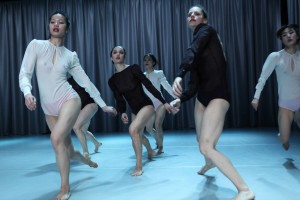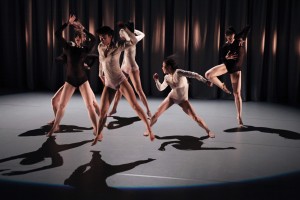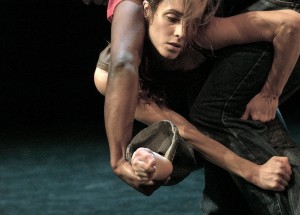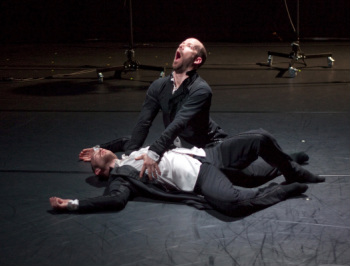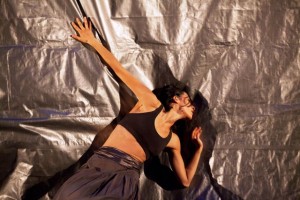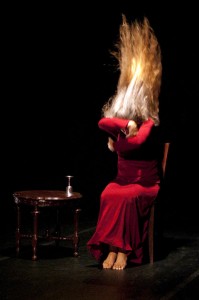By Rachel Straus
Toward the end of LeeSaar’s Princess Crocodile, seven female dancers line up, open their red-painted mouths and—like it’s the most mundane thing in the world—wildly wag their tongues at the audience. This culminating act lasts a good minute. It’s oddly fitting, and it becomes the theatrical highlight of the husband-wife team Saar Harari and Lee Sher’s newest work, seen April 10 at the Baryshnikov Arts Center’s Howard Gilman Performance Space.
In the previous 50 minutes of Princess Crocodile, the dancers juxtapose gracefulness and grotesquery, anger and happiness, feminine wiles and sangfroid—in second-by-second alternations. Consequently, when all of these contrasting, expressive modes fuse in the imperiously aggressive, tongue wagging lineup, it’s a huge relief.
These princess crocodiles seem to be saying, “Fetch me my crown. Or I’ll eat you!”
The lineup felt like the most authentic event in the show, perhaps because the dancers knew that it was silly and straightforward (instead of complex and profound). The wagging underscored the troupe’s strength too: its dancers’ tongues are as limber and expressive as their limbs, and that’s something to talk about.
Princess Crocodile, according to the press release, is about the “contradictions of female identity.” Created in two residencies at the Baryshnikov Arts Center, the choreography is influenced by the movement style Gaga, created by Ohad Naharin. Though the choreographers never danced with Naharin, the artistic director of Batsheva Dance Company, they are friends with him and teach Gaga classes, rooted in improvisatory, sensed perceptions to explore range of movement. Like Naharin, Sher and Harari also set their work to a collage of music, which is also assembled to create juxtapositions. In Princess Crocodile, an excerpt from Mahler’s Symphony No. 5 precedes the song Good Times by Animal House.
The most provocative use of music occurs in the work’s opening. Under a pool of luminous light (designed by Avi Yona Bueno), dancer Hyerin Lee sits on the floor in a swastika position (for dancers it’s called Graham fourth). She sharply gestures in response to the solo violin in the prologue of Stravinsky’s Apollo. For anyone acquainted with Balanchine’s pre-1978 Apollo, its prologue to Stravinsky’s music featured a lone figure: the mortal Leda. She gives birth to her immortal son. When Balanchine cut the Leda role, his Apollo became that much more male centric. It’s no accident that by quoting Leda, Harari and Sher are making a feminist statement. Their decade-long, New York-based troupe has always been all female, and much of their repertoire investigates Western image-making of women. When Lee dances angry and laughs like a madwoman, Balanchine’s disappeared Leda returns to the New York stage.
This feminist approach is admirable, but for all of Princess Crocodile’s good intentions, the dance seems to build rather than dismantle patriarchal presentations of women. LeeSaar dancers aren’t figures of agency who act with definitiveness. They are constantly changing their minds about which direction to travel through space, how to extend their limbs, and to look at the audience. The structure of the vignettes, let alone the sheer number of them, becomes a viewing challenge, particularly because they end ambiguously (such as when two women smell, nuzzle and kiss each other. Is this a lesbian scene? Are they schoolgirls? Are they crocodiles sharing the sun?). The emphasis on ambiguity in Princess Crocodile, and the frontal approach in much of the choreography, brings to mind the stereotype of the fickle woman, unable to decide how a piece of clothing looks on her in a dressing room mirror. So, she looks and looks. This idea is enforced by Bueno’s set design, which resembles a high-end dressing room, with its opalescent silken curtains. The curtains fall on three sides of the stage. Is the proscenium supposed to be a mirror?
While Princess Crocodile leaves one wondering what Harari and Sher think they are expressing, there is no doubt that they beautifully develop their dancers. Their off- kilter balances, gravity rich squats, and waving spines are physicalized versions of introspective humming. When Candice Schnurr takes gigantic walks on invisible high heels to the flamenco song Que Sen Ven Desde El Conquero (translation: Just Coming from the Conqueror), she magically embodies a gazelle genetically crossed with a defiant gypsy dancer.
